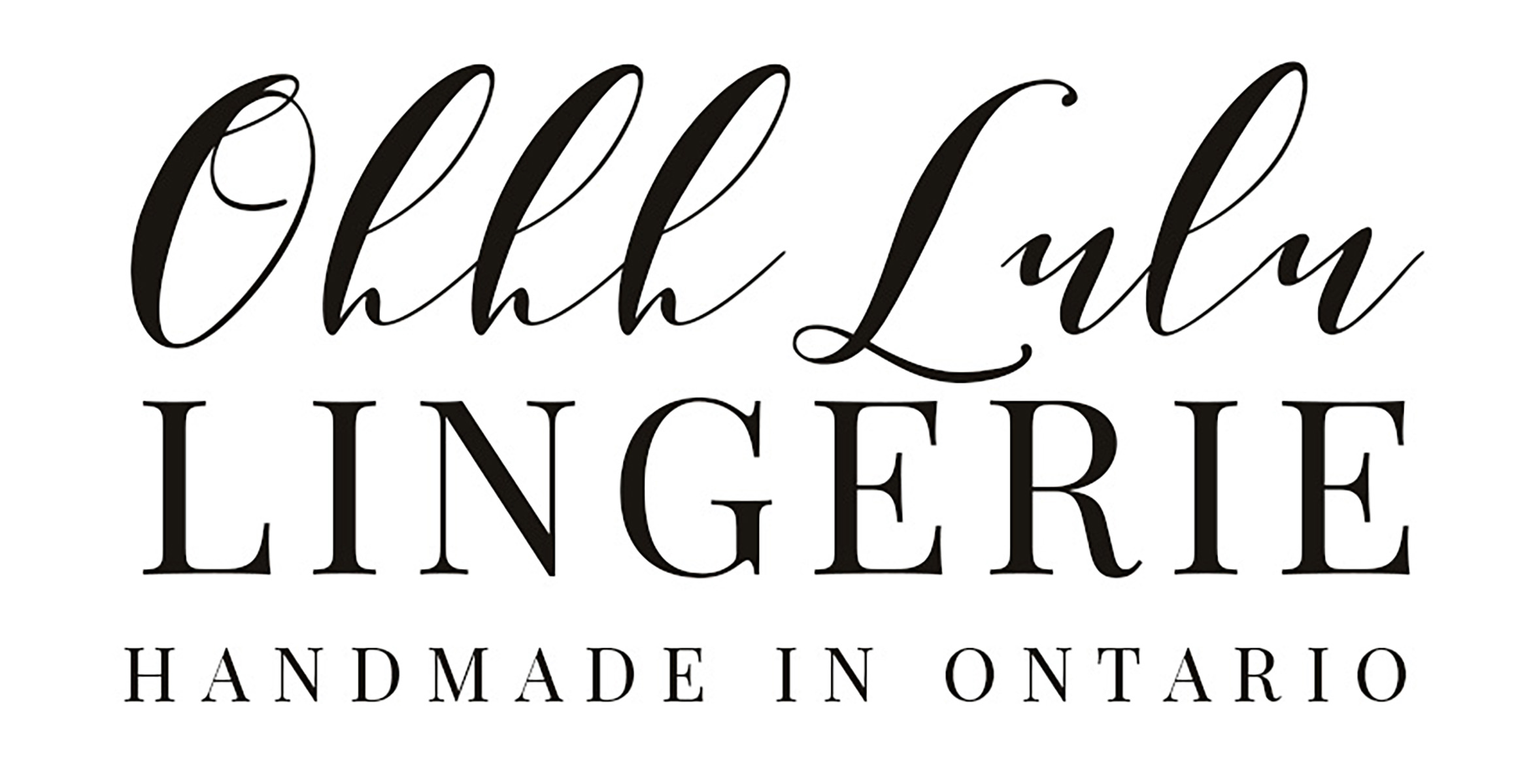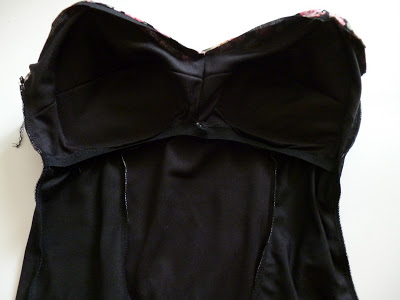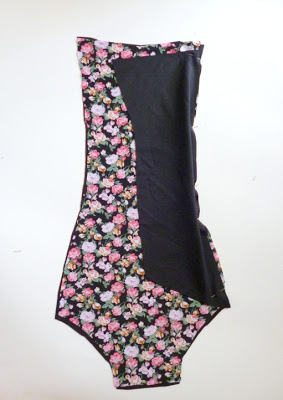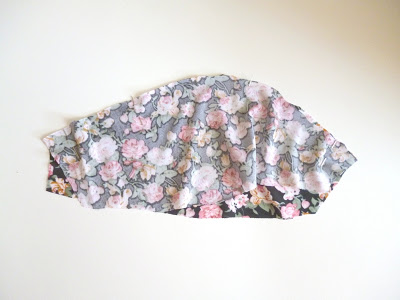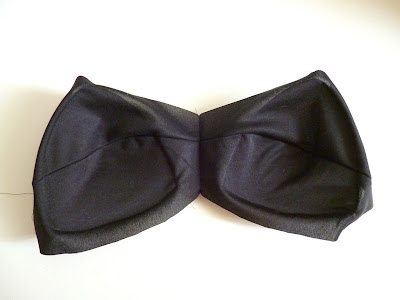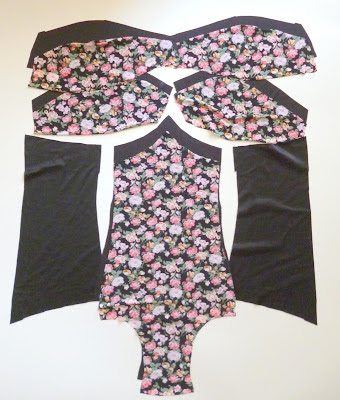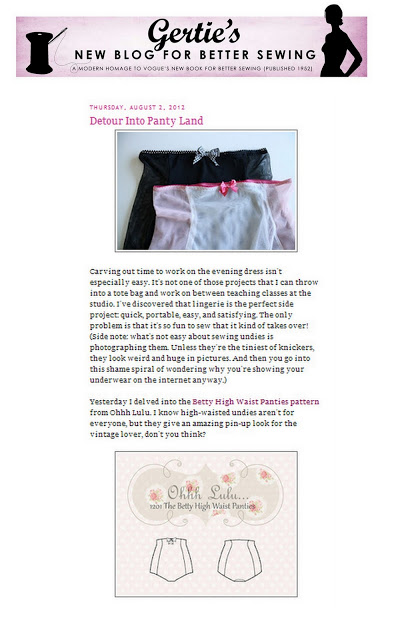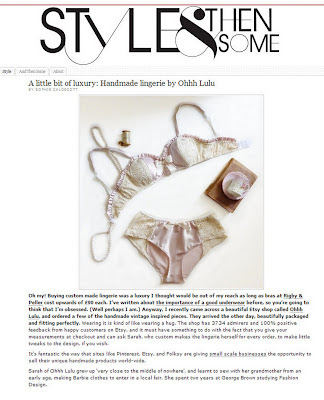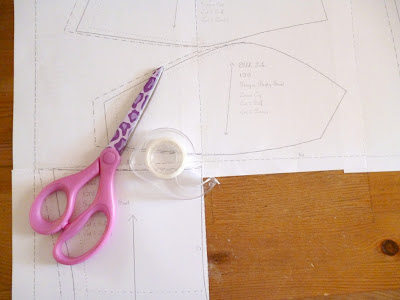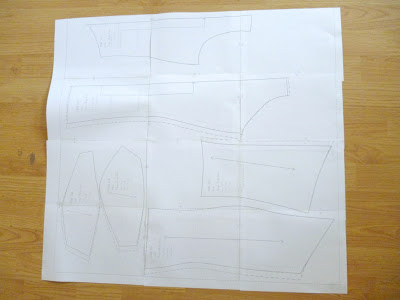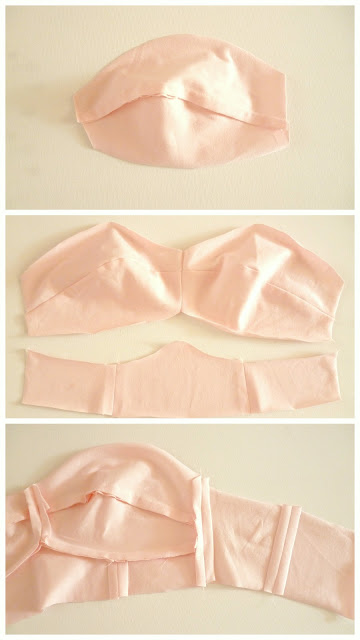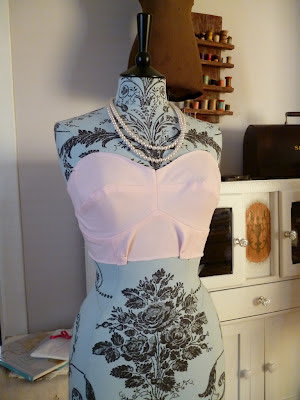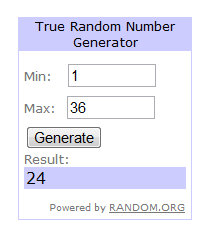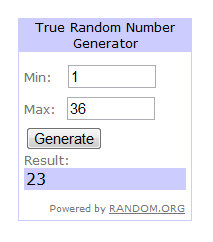Line your elastic up with the seam line, so that the excess of the elastic hangs over the seam allowance. Using a long zig-zag stitch, make a couple of stitches through your elastic and your seam allowance to anchor the elastic. As you sew, gently pull the elastic so you create just a LITTLE bit of tension. We want the elastic to just hold the base of the cups closer to our bodies, we do not want to pull so tight that it shirrs the fabric.
Once you have completed sewing the side fronts to the centre, you can stitch your bust cups on. I start my stitching line from the centre. For me this is the best way to keep that nice sharp point where the cups meet in the centre!
Well Dan got that job, so I’ve lost my house-husband/ chauffeur! But I am very excited for him to start this new venture!
I am so grateful it is Thursday already… This has been one heck of a week! On Tuesday morning, Dan got let go from his job. He had already been handing out resumes because work had been slow and he wasn’t enjoying it there, and was lucky to get an interview pretty quickly, but it still came as quite a shock, and I can’t help but feel a bit of deja vu! Didn’t this happen last summer, at a franchise that also started with an “M”? Weird!
The timing for these things is always so peculiar – right on the cusp of me being ready to take the leap! Ohhh Lulu is doing so fantastic right now, but it is hard to rely solely on a small business. Luckily I talked to my boss about how overwhelmed I am with the amount of work on my plate, and she is open to the idea of me doing 2 or 3 days a week at the office, and training someone to do what I do there. My day job has it’s moments of serious frustration, but working for someone who is an entrepreneur herself, she understand my position.
Of course, on top of that, is life. I had my yearly (ok, once in three years…) check up yesterday and am healthy, but need to have blood work, an ultrasound for an ongoing “issue”, an eye exam because I am having headaches from straining my eyes over my sewing machine…. so I need to fit all this life-business in as well. So, the next time you see me, I may be wearing some chic reading glasses. My doctor says this is what happens when you get “older!” While I’d rather be spending my time sewing than waiting in the Doctor’s office, I will be happy to be able to see and not get so many headaches…
On the fantastic side of things, since Tuesday, Dan has had an interview at a shop that sounds great – nice work atmosphere, and great pay. He also has been looking into another job, not quite as a mechanic, but working with cars, that he is very interested in. So, I feel hopeful and excited for Dan to move on to a new position… I never liked the place he was working at anyway!
So, that is life right now, nothing I can’t handle and am not terribly stressed about it. It’s nice to have a stay-at-home husband to clean the house and chauffeur you everywhere. I could really get used to it!
Taking your own measurements isn’t easy. First of all, sometimes it’s a shock to see what the numbers actually show. Secondly, many people are unsure of where their natural waist or hip is. Unless you’ve taken a fitting course, it’s not really common knowledge. I wanted to show where to measure on a *real* body – We have all seen measurement diagrams on a croquis, but because no one looks like a fashion croquis, it can be hard to relate it back to our actual bodies.
Your hips, like your bust, should be measured around the fullest point. Take along look at yourself straight on in the mirror, as well as in profile. You want to wrap the tape comfortable around your seat. Here’s your hip measurement.
Your High Hip sits around where a pair of hipster panties would sit. This is a helpful measurement for fitting.
Sew 1/2″ away from the raw edge. I’m straight stitching mine.
Any time you sew a seam that curves out, you always have to notch your seam allowance, so that when you press your seam allowance open, you avoid any extra bulk.
Once you have assembled both cups, sew them together down the centre seam. To ensure that the horizontal lines running across the bust match up, I often place them together (right sides together), and make a small tack on the sewing machine, through the seam that I want to match up. I find this works better than pins, because pins can slip. This is an easy way to get seams that match up, every time.
After you have sewing your lining and your self, and notched your seam allowance, using a pressing ham, press your seams open.
Now we are sewing our cups to our lining. Mine sit about 1″ up from my raw edge at the end, and about 1/2″ up from my raw edge, towards the middle of the cup. I want to avoid getting the cup stuck in the seam where the body of the swim suit gets stitched on. This is why I have placed it here.
- Cut 2 of the Upper Cup in Self and in Lining
- Cut 2 of the Lower Cup in Self and in Lining
- Cut 1 on fold of the Centre Front in Self and in Lining
- Cut 1 on fold of the Centre Back in Self and in Lining
- Cut 2 Side front in Self – optional to cut lining too. I am using a heavy spandex so I didn’t feel I needed a lining. If you are using a light coloured fabric, or an unstable knit, line it!
- Cut 2 Side back in Self – lining here is optional too
Why line a swimsuit if your fabric is opaque? Lining does a couple of things. It gives your fabric stability – especially if you are not using a spandex swimsuit fabric. Fabric clings when they are wet, proudly displaying every nook and cranny that you may not necessarily want on display at the local beach. Lining gives you that extra layer. Lighter fabrics, as many of us know, lose their opacity when wet. Lining will prevent an unwanted “Surprise” when you emerge from the water. So, the moral of the story is, it’s very important to line a swimsuit.
Pins are your friend when cutting knits. When sewing for myself, I am sometimes so excited to get a project underway, that I am skimpy on the pinning. Properly pinning your fabric will prevent it from sliding, so you’re sure to get exact cuts each time.
**If you are sewing a 2 piece version, you follow these directions exactly, except that you cut along the waist lines** I’ve included a crotch lining gusset piece for people who may want to sew the bottoms as panties, but don’t want a fully lined garment. You will find that the crotch seam on this garment sits pretty close to the middle of the legs, which slightly off-sets the crotch lining, providing more coverage up front than towards the back.
Remember the lovely padded sets I made a few weeks back? Well, I was so please to see the recipient wrote this amazing post on Style & Then Some. Sophie was such a doll to work with. Feedback like this quite literally brings a tear to my eye. After years of working hard and doing jobs I didn’t really want to do (and sometimes down right hated), it is so rewarding to be able to do something that I love, and to make something that other people cherish.
Thanks everyone! It has been a great week! I am excited to have a 4 day weekend this weekend, and a mini vacation coming up. I’ll be sticking around the house, sewing, gardening, dog-sitting, and of course, blogging
First, print your PDF Pattern – make sure that you have selected “none” for page scaling. Cut along the dotted lines of the margins and tape your pieces together. Use the Alpha Numeric markings as a guide so your pages don’t get mixed up. For me, this is a large pattern – 12 pages, and some pattern pieces look similar, so it’s easy to get mixed up.
Fold your fabric on a 45 degree angle to the selvedge, this is the “Bias”. Place your front and back pieces on the fold, and cut out.
Cut 1 Crotch piece in jersey lining & your self fabric.
You have a total of four pieces – 2 crotch pieces (one lining, one self), and a front and a back.
Layer your crotch pieces, wrong sides together. Treat them as one piece from here on in.
Stitch your back crotch seam to the back thong piece, and the front crotch seam to the front thong piece. I serge mine. You can straight stitch, and zig zag. Optional, you can topstitch down.
Finish your leg openings with a rolled edge, pearl stitch, OR simply fold under and zig-zag stitch. You can also zig-zag stitch stretch lace around the leg openings.
Now it’s time to apply your elastic. Take your shorter length of elastic, and pin along the leg opening, ½” to ⅝” away from the finished edge. The elastic is considerably shorter than the leg opening – this will create the ruffle effect. You will want to pin the elastic to the start of your leg opening (on the wrong side), at the end of the leg opening, and in the middle, so that the thong will ruffle evenly the whole way around.
Using a narrow zig-zag stitch, and pulling the elastic evenly as you stitch, sew your elastic onto the wrong side of the thong. As you sew you will see that the elastic gathers the fabric, creating a ruffled effect. Finish both leg openings in this manner.
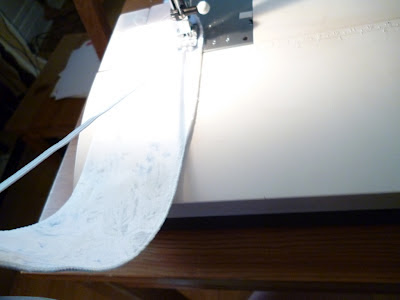 |
| The Elastic is much shorter than the length of fabric you are sewing it on to |
To finish, pearl stitch your waist band (or zigzag, add lace, etc), and sew up your final side seam. Top with a bow, rosette, or leave plain.
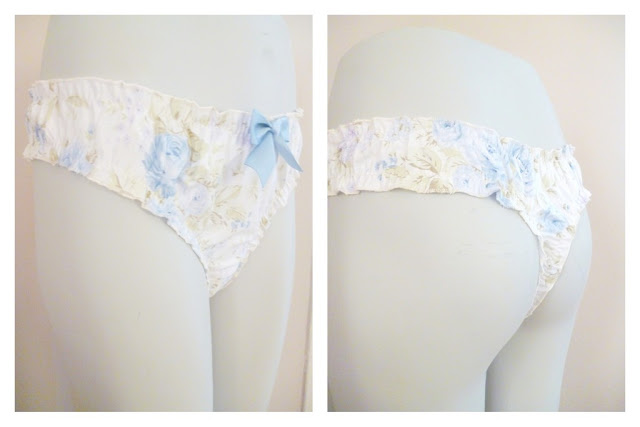 |
| Ta Da! |
